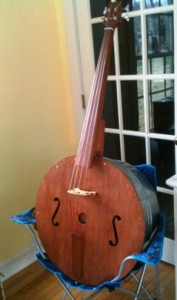The Built-Wells Upright 4-String Washtub Bass: As discussed on Thunder Radio’s Bluegrass Crossroads Show (listen here), appearing on our CD, and maybe at a music festival near you.
I’ve been a wannabe musician for a long time, and the “wanna” has grown stronger in recent years as I’ve seen how much fun goes on at bluegrass and old-time music festivals. I’ve squeezed into a circle of musicians with a video cam at plenty of jams, often filming my daughter Kelsey, an old-time fiddler, and her friends. It’s a lot of fun to be right there with the action, but I found myself wanting something else. Something with strings.
Despite my longing for them, strings intimidated me. It may seem silly, but after I’ve plunked a bit on the piano on and off for decades, strings seemed terribly foreign. Of the likely culprits – banjo, guitar, fiddle, etc. – I was most attracted to the bass. But how practical is that, I wondered? So large. Kind of pricey to even try. So how about a bass with just one string? I’d see the occasional washtub bass at festivals – you know the kind – a broomstick, a washtub, and a string – and I kept thinking to myself, “Surely I could play that.” At Uncle Dave Macon Days one year, I finally worked up my courage to ask for an impromptu lesson on one, and soon found myself happily jamming on the porch of the Leeman House.
I was not, it must be noted, proficiently jamming, as it’s harder than it looks. But my happy enthusiasm made up for the shortcomings in my technique, it seemed. Fueled by the euphoria of playing tunes like “Angelina Baker” with other musicians, I came home with the idea that my very handy fella could build me a washtub bass of my own. So I Googled “washtub bass,” and what should I find? A 4-string variety. With handy-dandy DIY plans posted by this man, Dennis Havlena, who has built numerous cool instruments. My mind whirled. If I had enjoyed one string so much, then how much better would four be? (Remember, I was in my post-jam euphoric period, prior to calluses, blisters, etc.) Plus, this would be a way to have something more like a real bass at a fraction of the cost – and with a lot of quirky personality. I printed the plans and took them to Honey. And here’s what happened:
For more photos and some explanatory notes, see this photo album on the Kory & Kelsey Facebook page.
We didn’t follow Mr. Havlena’s plans exactly, but they were very helpful. I also found myself Googling all sorts of things about instrument construction as we went along, to help us make decisions on things like the bass bar, sound post, and more. If we were building another one, I’d try for one that was a little louder and a little taller (we intentionally made it short for me), not to mention getting the f-holes in the right direction (ahem), but it’s not bad at all for a first try.

My first jam, at the Great Southern Old Time Fiddlers Convention, 2012.
I practice at home by playing along with YouTube videos of some of my favorite tunes. I still can’t keep up with Kelsey’s pace on most tunes, but I’m working on it. When we’re at a festival with the bass, almost every “real musician” who stops by makes it sound better than I do, which could be frustrating, but is mostly inspiring. I may always be a wannabe musician, but I’ve got a unique instrument that was a fun project to build with my favorite handyman.
Listen to our interview on Thunder Crossroads Bluegrass Show (originally aired 8/10/2013)



can you purchase one of these and if so what is price
We just made this one for ourselves, Randy- and I don’t think I’m going to talk my husband into going into production. Thanks for your interest!
I’ve got to try my hand at making one of these. Thanks for the inspiration.
You’re welcome, Steve! Have fun with it!
Thanks for sharing on the website. I just finished one of these basses 12/24/2017. Well, actually I just made it to “playable” stage. Still need to adjust nut (mine’s maple)and bridge, clean it up, shape neck a little more, and put a finish on it here and there. I made a scroll headstock, which makes it looks a little more fancy, and was my first attempt at that carving journey. “Fraction of the cost. . . quirk personality” attracted me also.
Congrats on your custom instrument, Craig! I confess I haven’t been playing mine as much lately (I took up the ukelele, which is slightly more portable), but I still love mine – and have ideas for version 2.0, one of these days. 🙂 Enjoy!
I recently finished building a “4 string suitcase upright bass” that I am really very happy with so far. While I started out playing the bass guitar as a kid, I ended up learning many other instruments (banjo, mando, electric/acoustic guitar, lap steel, dobro, harmonica etc) and I ended up playing pretty much all of them in a band I used to be in (it was pretty stressful to have all that gear to set up and strings to keep in tune though!) that spent 5+ years touring America/Europe. The last upright bass player that was with us also would open for us most nights playing his solo stuff, which I would describe as very dirty and “punked “ out, high energy delta blues mixed with some folk punk, rockabilly and country. Now when we first started as a band we had built a 3 string upright washtub bass that’s similar to yours which, while I wasn’t the bass player, I had messed around with quite a bit- at least enough to get the basic “slap” down and the notes always came quite easy because I had been a pretty good bass guitar player when I was younger. So long story short, I eventually started playing upright bass with our bass player during his solo set (which he played guitar and sang for) and ended up totally hooked on upright bass.
The problem is that I’m pretty poor these days because the band I was in broke up and now not only am I musician but I also am unemployed musician, so buying an upright wasn’t really an option- at least right now. What I do have on my hand is time and a slight issue with hoarding things I think might be cool to use in some potential future project that may or may not ever manifest. One of my “hoards” was a big old suitcase that I got from a free pile that ended up being perfect for the body of the bass. For the rest of the stuff the bass needs I was able to utilize an old hardwood kitchen table I found in our unfinished basement gathering dust and mold. I carved my own bridge, cut and sanded my own neck (with a jig saw!) and fingerboard and yanked the tuning machines off of my epiphone bass guitar to use on the new upright. For strings I used “Superior Bassworks” synthetic gut strings which are kind of like the most amazing and not harsh and dinky sounding weedwhacker strings- although they are really much better sounding and better feeling to play then any weedwhack strings out there. It’s still somewhat of a work in progress and I’m still trying to find all the little buzzes, rattles and squeaks coming from various parts of the suitcase and neck and hopefully stop them or at least keep them at bay.
Here’s some pictures- I have a couple videos of me playing it but I shot them with my phone so you only really hear the slap, especially if listening on a phone. I might try and make a video with the bass mic’d up close (or at least one using a decent sounding condenser mic or maybe a ribbon mic, to pick up something approximating the natural sound you hear in the room) so if I do throw it up on YouTube or something I’ll swing back by and leave a link for anyone looking for additional ideas and inspiration for their own potential builds. I know this was one of the many sites I stumbled upon on my “DIY upright bass” searches and it’s always helpful to get more info and see more finished basses. If your thinking you might wanna build something like this then I would say you should absolutely go for it. Even if you havent done much in the way of carpentry (nevermind luthier work), it’s certainly do able with very little in the way of tools and experience.
Be prepared for your first attempt to have some issues you gotta troubleshoot before your gonna be anywhere close to satisfied with what you’ve made. Who knows, maybe you’ll build it perfect the first time and not have to worry about tweaking it but it’s good to anticipate it needing adjustments. I would also recommend Dennis Havlena’s site and his plans for a washtub upright bass that have been online for almost 20 years and probably inspired and helped guide the construction of thousands of diy upright bssses- most of them being washtubs as that’s what the plans are actually for- but I was able to adapt aspects of his plans to my suitcase without too much difficulty. Another thing I wish I had known about before starting this project was that you really need to reinforce most suitcases in order to have them support the several hundred pounds of pressure once the strings are put on. I hadn’t thought of this and thus my “soundboard” was pretty quickly caved in, albeit very slightly but still somewhat noticeable up close. Also if your
going to use Dennis’s plans but adapt them to something like a suitcase, you may be better off omitting the main piece of softwood that you attack the neck to and instead attach a top and bottom block to the top and bottoms of the inside of the suitcase which will also help provide much needed sturdiness and give you something you can attach your neck on to (just make sure it’s hard enough wood to withstand the string pressure).
A friend of mine who has built several suitcase basses as well as a bad ass 4 string upright “gas tank” bass that sounded incredible when I saw him play it with the band “Cletus Got Shot” from Fayetteville Arkansas back when I was touring with my old band (Filthy Still, if your curious and want to check us out- warning though there are some somewhat explicit song lyrics in some of our songs- it’s all in good fun though- you can hear our stuff on filthystill.bandcamp.com as well as on YouTube, Spotify, Apple Music etc) had seen a social media post about me wanting to make a suitcase bass so he sent me a quick little video showing me the inside of his bass and giving me a quick run down on how he built it and also how it is able to be fairly simply disassembled and broken down to fit into the suitcase for easy traveling purposes- something I certainly wished we had had on both of European tours as we ended up having to rent/borrow an upright when we got over there. I will post it to my YouTube today as a resource for people who want to attempt to make something similar. For me, it not being able to break down is fine for the moment as I’m not doing much in the way of touring and even if I did I’d be bringing my guitar, banjo, uke etc for my solo set. I’ve mostly been using this bass to record bass parts on all my solo songs that I’ve been working on for my second solo album. I’ve been able to get a few of my bass playing friends to record a bass part for a song (or songs) I’ve sent them by e-mail but it’s not always that easy or convenient to have to wait until my lazy musician friends get motivated enough to record a bass line for me so this build has been very helpful in that sense.
I’m still working on figuring out the best choice of mic and mic placement in combination with a few different DIY piezo pick ups that I’ve been experimenting with to attempt to find the spot that picks up the tone of the instrument in the most natural sounding and full sounding way possible. For recording strictly the “low end” of a suitcase or really any incarnation of a double bass, I have experimented with using a few different med/small size speakers as microphones which is as easy as wiring the speaker up to a 1/4” cable and then plugging it into a DI, recording interface, preamp or perhaps it would even sound decent through a bass amp- although I would be careful that it doesn’t start feeding back in those extremely
low frequencies as they can create a sort of feedback loop of different resonances and harmonics that can be pretty loud and unpleasant, could even damage your bass amp but you won’t know until you try I suppose. OK folks, that’s it for me here- sorry this is so long I wrote way more than I intended too but I felt that this information might be helpful to someone and I have a bad habit of being unable to leave stuff out of my writing as it makes me feel like I’m being somewhat dishonest. Oh yeah here’s Dennis Havlena’s plans for the upright washtub:
http://dennishavlena.com/db.htm
Thanks for all the info you’ve shared here, Matt (and sorry I didn’t see your comment to approve for a couple of weeks). The suitcase bass sounds awesome! And here at our house we also tend to hoard for creative projects. As you may have seen somewhere on my site, we used Dennis’s plans as a starting point, too – very helpful. All best, Kory